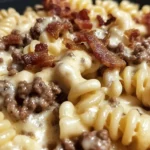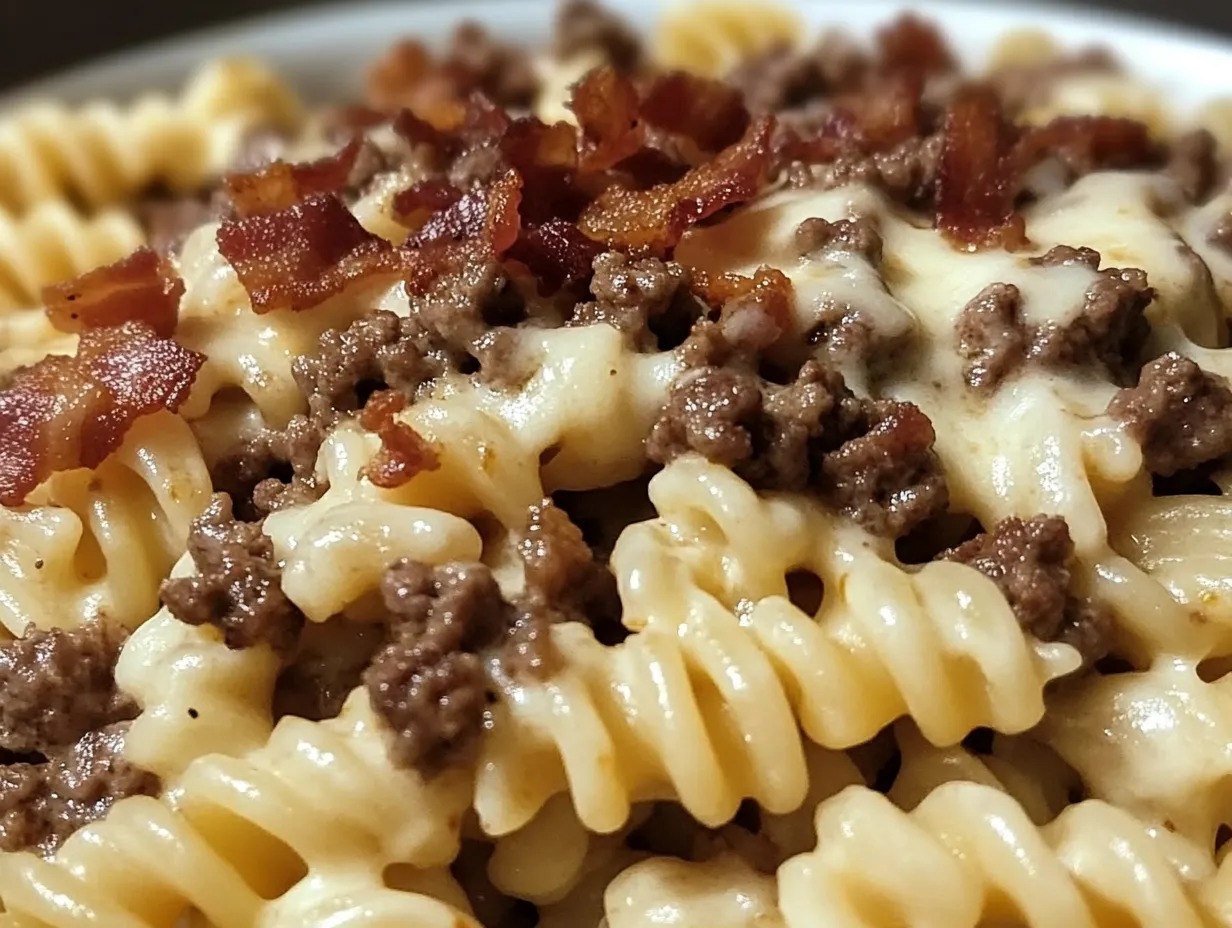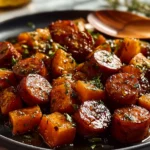Cheeseburger Pasta with Turkey Bacon is a delightful twist on classic comfort food, bringing together the familiar flavors of a cheeseburger in a creamy, one-pot pasta dish. This recipe combines juicy ground beef, savory cheddar cheese, and crispy turkey bacon, creating a smoky, satisfying taste with every bite. It’s a unique fusion of flavors: the tanginess of ketchup and mustard brings out the classic cheeseburger taste, while the pasta adds heartiness that makes this meal perfect for family dinners.
Ideal for weeknights, this dish is quick to prepare, using basic ingredients in a single pot—saving time on both cooking and cleanup. Its rich, creamy texture and indulgent flavors make it a crowd-pleaser that everyone will love, from kids to adults. Whether you’re craving comfort food or need a simple, filling meal, Cheeseburger Pasta with Turkey Bacon is a delicious choice that’s sure to satisfy.
Key Ingredients and Their Role
Each ingredient in Cheeseburger Pasta with Turkey Bacon plays a unique role in building the dish’s flavors, textures, and overall appeal. Here’s a breakdown of the key components:
- Turkey Bacon: Turkey bacon adds a smoky, savory flavor without the extra fat of traditional bacon, offering a healthier alternative that still delivers that irresistible crispy texture. Its slightly leaner profile complements the dish without overpowering it.
- Ground Beef (or Turkey): Ground beef serves as the primary protein, adding a rich, meaty flavor that mimics the taste of a classic cheeseburger. For a lighter version, ground turkey is a great alternative, providing a leaner base without compromising on flavor.
- Onion & Garlic: These aromatics are essential for the flavor foundation, infusing the dish with depth and warmth. As they sauté with the ground meat, they create a savory base that enhances the overall taste.
- Ketchup & Mustard: These pantry staples add a tangy kick and bring out the signature cheeseburger flavor profile. The ketchup provides sweetness and acidity, while the mustard introduces a slight sharpness that balances the richness of the other ingredients.
- Broth and Diced Tomatoes: Beef or chicken broth adds depth and savory notes while also serving as the liquid for cooking the pasta directly in the skillet, making it a convenient, one-pot meal. Diced tomatoes bring a touch of acidity and texture, blending well with the pasta and cheese.
- Cheddar Cheese & Heavy Cream: Shredded cheddar melts into the dish, creating a rich, creamy sauce that coats the pasta. Adding a splash of heavy cream (optional) boosts the creaminess, making the pasta extra indulgent.
Ingredient Swaps: For a leaner option, swap ground beef for ground turkey, or use chicken broth instead of beef broth for a lighter base. Gluten-free pasta can also be substituted for those with dietary restrictions. Each swap slightly adjusts the flavor profile while keeping the dish delicious and versatile.
Why Use Turkey Bacon Over Traditional Bacon?
Turkey bacon is an excellent choice for this dish, offering a healthier alternative to traditional pork bacon without sacrificing flavor. One of the primary benefits of turkey bacon is its lower fat content, which reduces the overall calorie load of the dish while still adding a satisfying crispiness and smoky flavor. Turkey bacon contains less saturated fat, making it a heart-friendly option that’s ideal for those seeking a lighter meal without losing the bacon essence.
The smoky, slightly lighter taste of turkey bacon complements the cheeseburger-inspired flavors of the pasta without overpowering them. It pairs seamlessly with the ground beef, cheddar cheese, and tangy ketchup, enhancing the dish’s flavor profile without excess greasiness. This makes the final dish feel indulgent but not overly heavy, perfect for anyone looking to enjoy a comforting meal that’s flavorful, balanced, and a bit healthier than the traditional version.
Tools and Utensils Needed
To prepare Cheeseburger Pasta with Turkey Bacon, you’ll need a few essential kitchen tools to ensure smooth cooking:
- Large Skillet or Pot: A large, deep skillet or pot is crucial for this one-pot meal, allowing ample space for all ingredients to cook evenly. The size helps prevent overcrowding, which is key for browning the meat properly and evenly cooking the pasta.
- Wooden or Silicone Stirring Spoon: This is perfect for stirring ingredients without scratching the pan surface, ensuring everything mixes well without sticking.
- Sharp Knife: Essential for chopping the turkey bacon, onion, and garlic precisely, giving you consistent pieces that cook uniformly.
These simple tools make preparation straightforward and minimize cleanup, allowing for a seamless, efficient cooking experience.
Step 1: Cooking the Turkey Bacon
Begin by heating 1 tablespoon of olive oil in a large skillet or pot over medium heat. Once the oil is warm, add the chopped turkey bacon. Spread it evenly across the skillet to ensure each piece has direct contact with the hot surface. Cook for about 4-5 minutes, stirring occasionally to avoid burning and to achieve an even crispiness.
For perfect texture, keep an eye on the bacon as it cooks. Turkey bacon crisps up quickly, so monitor it closely to avoid overcooking, which can make it tough. If the bacon starts to release too much moisture, increase the heat slightly to evaporate it, helping achieve a crisp, golden finish without excessive oiliness.
Once the turkey bacon is crispy, carefully remove it from the skillet with a slotted spoon, leaving the oil and flavorful bits in the pan. Set the bacon aside on a paper towel to drain any excess oil, and you’re ready for the next step!
Step 2: Browning the Ground Beef
In the same skillet with the reserved oil from the turkey bacon, add 1 pound of ground beef (or ground turkey for a leaner option). Cook the beef over medium-high heat, breaking it apart with a spoon to ensure even browning. Allow the meat to cook undisturbed for a few minutes before stirring, as this helps it develop a deeper, caramelized flavor.
Once the meat starts to brown, add 1 small diced onion and 2 cloves of minced garlic to the skillet. Stir these aromatics into the meat, letting them cook for about 3-4 minutes until the onion is softened and the garlic is fragrant. This combination builds a flavorful base that enhances the entire dish.
Season the mixture with salt and black pepper to taste, which brings out the natural flavors of the meat and aromatics. Proper seasoning at this stage ensures a well-balanced, savory taste throughout the dish, setting a solid foundation for the cheeseburger-inspired flavors to come.
Step 3: Adding Flavorings and Broth
With the browned ground beef, onion, and garlic mixture in the skillet, it’s time to introduce the signature cheeseburger flavors. Start by adding 1 tablespoon of ketchup and 1 tablespoon of yellow mustard. Stir these condiments into the meat thoroughly, allowing their tangy, slightly sweet flavors to meld with the beef, recreating the classic taste of a cheeseburger. The ketchup adds a touch of sweetness and acidity, while the mustard brings a mild sharpness that balances the richness of the meat.
Next, pour in 3 cups of beef broth (or chicken broth for a lighter option) and 1 can (14.5 oz) of diced tomatoes, including the juices. The broth acts as both the cooking liquid for the pasta and an enhancer of the savory, meaty flavors. Leaving the diced tomatoes undrained is essential; the extra liquid and natural acidity add depth, making the sauce richer and slightly tangy, reminiscent of a juicy cheeseburger.
Now, add 8 oz of pasta shells or elbow macaroni, stirring to ensure each piece is fully coated with the flavorful mixture. Mixing the pasta thoroughly is important for even cooking and to help it absorb all the flavors as it softens. With everything combined, bring the mixture to a gentle boil, ready for the next stage of simmering.
Step 4: Simmering for Optimal Pasta Texture
Once the pasta is fully mixed into the beef, broth, and tomato mixture, bring the skillet to a gentle boil. Then, immediately reduce the heat to low and cover the skillet. Allow the pasta to simmer for 10-12 minutes, stirring occasionally to ensure even cooking and prevent any pasta from sticking to the bottom of the skillet.
Simmering on low heat is essential to cooking the pasta to an al dente texture, where it’s tender but still has a slight firmness in the center. To avoid mushy pasta, keep the heat low and check the texture as you stir, adding a splash of water or broth if the liquid reduces too quickly. By maintaining low heat and stirring occasionally, the pasta absorbs the savory flavors without overcooking, resulting in a perfectly creamy, cohesive dish that’s ready for the final touches.
Step 5: Adding Cheese and Optional Cream
Once the pasta is cooked to al dente, it’s time to add the creamy, cheesy goodness. Lower the heat to a gentle simmer and sprinkle 2 cups of shredded cheddar cheese evenly over the pasta. Stir continuously as the cheese melts, creating a smooth, rich sauce that coats every piece of pasta. To ensure the cheese melts smoothly without clumping, make sure the heat is low, as high heat can cause the cheese to separate or become grainy.
For those who prefer an extra creamy texture, add ¼ cup of heavy cream at this stage. The cream should be added after the cheese has mostly melted, blending gently into the sauce to enhance its richness without overpowering the cheesiness. Stir until the cream is fully incorporated and the sauce reaches your desired consistency—smooth, velvety, and indulgent. This optional addition elevates the dish’s comfort factor, making it extra luscious and satisfying.
Step 6: Bringing Back the Turkey Bacon
With the cheese melted and the sauce perfectly creamy, it’s time to reintroduce the crispy turkey bacon for a final layer of flavor. Add the reserved turkey bacon back into the skillet, stirring gently to distribute it evenly throughout the pasta. This ensures every bite has a bit of that smoky, savory bacon flavor.
To achieve even distribution, fold the bacon into the pasta gradually, using a spoon to mix thoroughly. This step gives the dish a delightful texture contrast, balancing the creaminess with the crispy bites of bacon, and elevates the overall flavor to a satisfying finish.
Step 7: Garnishing and Serving Suggestions
For a fresh, vibrant finishing touch, garnish the Cheeseburger Pasta with a sprinkle of chopped parsley or chives. These herbs add a pop of color and a hint of freshness that balances the rich, creamy flavors of the dish. A handful of fresh parsley offers a mild, slightly peppery taste, while chives add a subtle onion-like flavor that complements the other ingredients.
When it comes to serving, consider pairing this comforting pasta with a crisp side salad to add a refreshing contrast. A simple green salad with a light vinaigrette works well to cleanse the palate and balance the dish’s richness. For a heartier meal, serve the pasta alongside warm garlic bread—the buttery, garlicky flavors pair perfectly with the cheesy, smoky pasta. Present the dish in a large, shallow bowl to highlight the creamy sauce, crispy bacon pieces, and vibrant garnish for an inviting, restaurant-style presentation that’s sure to impress.
Tips for the Perfect Cheeseburger Pasta
Creating the perfect Cheeseburger Pasta is all about balancing flavors, textures, and making adjustments to suit personal preferences. Here are some tips to make it just right:
- Adjusting Flavors: For more of a classic cheeseburger tang, add an extra teaspoon of mustard or an additional tablespoon of ketchup to heighten the tangy-sweet notes. If you prefer a richer dish, increase the cheddar cheese by an additional ½ cup for more creaminess and depth.
- Achieving a Balanced, Non-Greasy Consistency: To keep the pasta from becoming too greasy, stick to lean ground beef or substitute with ground turkey for an even lighter option. Cooking the turkey bacon separately and draining any excess grease from the skillet before adding other ingredients will also prevent an overly oily finish. Adding heavy cream in small amounts (if used) helps create a creamy texture without making the sauce feel heavy.
- Ingredient Swaps for Dietary Preferences:
- For a gluten-free version, simply use gluten-free pasta, such as chickpea or rice-based options, which cook similarly in the sauce.
- To make it vegetarian, replace the ground beef with plant-based ground meat or crumbled tofu for a hearty texture. Use vegetable broth instead of beef broth, and skip the turkey bacon, possibly adding a few drops of liquid smoke to retain that smoky flavor.
These small tweaks and adjustments can customize the dish to your liking while ensuring a balanced, satisfying pasta with all the flavors of a cheeseburger.
Nutritional Information
A serving of Cheeseburger Pasta with Turkey Bacon is approximately 500-600 calories, depending on ingredient variations and portion size. Each serving generally contains around 25-30 grams of protein, thanks to the ground beef and turkey bacon, with 20-25 grams of fat from the cheese, meat, and optional cream.
For a lighter version, using lean ground beef or ground turkey can significantly reduce fat content, lowering the overall calorie count while still providing ample protein. Substituting turkey bacon also cuts down on saturated fat compared to traditional bacon, making this dish a more balanced choice for those watching their calorie intake. This nutritional balance makes Cheeseburger Pasta a filling, protein-rich meal that satisfies without going overboard on calories.
Storage and Reheating Tips
To store any leftover Cheeseburger Pasta with Turkey Bacon, transfer it to an airtight container once it has cooled. It will keep well in the refrigerator for up to 3 days or can be frozen for longer storage—up to 2 months. If freezing, portion the pasta into individual servings for easy reheating.
For the best reheating results, use the stovetop method. Place the pasta in a skillet over medium-low heat and add a splash of broth or water to help loosen the sauce and maintain its creamy consistency. Stir occasionally until the pasta is heated through. If using a microwave, heat in short bursts (30-45 seconds), stirring in between to ensure even heating and prevent the sauce from separating.
Reheating slowly and adding a bit of liquid helps preserve the pasta’s texture and flavor, making leftovers as satisfying as the first serving.
FAQs About Cheeseburger Pasta with Turkey Bacon
- Can I use regular bacon instead of turkey bacon?
Yes, you can substitute regular bacon for turkey bacon, but keep in mind that it will increase the fat content and may make the dish a bit richer. Regular bacon also has a stronger flavor, which can alter the overall taste slightly. - What type of pasta works best in cheeseburger pasta?
Short pasta varieties, like shells or elbow macaroni, work best because they hold the sauce well, allowing every bite to be coated with the creamy, cheesy flavors. Other short pastas, like rotini or penne, can also work as substitutes. - How can I make this recipe gluten-free?
To make this dish gluten-free, simply substitute regular pasta with a gluten-free option, such as rice, chickpea, or lentil pasta. Also, double-check that other ingredients, like broth and condiments, are labeled gluten-free. - Can I make it ahead of time?
Yes, Cheeseburger Pasta can be made ahead and stored in the refrigerator for up to 3 days. When reheating, add a splash of broth or water to help the sauce stay creamy and avoid dryness. - Is there a vegetarian alternative to ground beef?
Absolutely! You can use plant-based ground meat, crumbled tofu, or even lentils for a vegetarian option. Add a bit of liquid smoke or smoked paprika for a hint of that traditional smokiness, ensuring a flavorful and satisfying meat-free version.

Cheeseburger Pasta with Turkey Bacon
- Author: Munil
Description
This one-pot cheeseburger pasta dish brings together the classic flavors of a cheeseburger in a creamy, cheesy pasta with a smoky twist from turkey bacon. It’s quick, hearty, and perfect for weeknight dinners!
Ingredients
- 1 tbsp olive oil
- 6 slices turkey bacon, chopped
- 1 lb (450 g) ground beef (or ground turkey for a leaner option)
- 1 small onion, diced
- 2 cloves garlic, minced
- Salt and black pepper, to taste
- 1 tbsp ketchup
- 1 tbsp yellow mustard
- 3 cups beef broth (or chicken broth)
- 1 can (14.5 oz) diced tomatoes, undrained
- 8 oz (225 g) pasta shells or elbow macaroni
- 2 cups shredded cheddar cheese
- ¼ cup heavy cream (optional, for extra creaminess)
- Fresh parsley or chives, chopped (for garnish)
Instructions
1️⃣ Cook the Turkey Bacon:
In a large skillet or pot, heat the olive oil over medium heat. Add the chopped turkey bacon and cook until it’s crispy, about 4-5 minutes. Remove the bacon from the skillet and set aside, leaving the oil in the pan.
2️⃣ Brown the Ground Beef:
In the same skillet, add the ground beef and cook until browned, breaking it apart with a spoon. Add the diced onion and minced garlic, and cook until the onion is softened, about 3-4 minutes. Season with salt and pepper to taste.
3️⃣ Add Flavorings and Broth:
Stir in the ketchup and mustard, mixing well. Pour in the beef broth and undrained diced tomatoes, then add the pasta. Stir to combine.
4️⃣ Simmer:
Bring the mixture to a gentle boil, then reduce the heat to low. Cover and simmer for 10-12 minutes, or until the pasta is cooked al dente, stirring occasionally.
5️⃣ Add Cheese and Cream:
Once the pasta is cooked, add the shredded cheddar cheese and stir until melted and creamy. For an extra creamy texture, stir in the heavy cream (optional).
6️⃣ Finish with Turkey Bacon:
Add the cooked turkey bacon back to the skillet, stirring to combine.
7️⃣ Serve:
Garnish with chopped parsley or chives and serve hot. Enjoy the comforting flavors of cheeseburger pasta with a smoky turkey bacon twist!
Notes
- Storage: Refrigerate leftovers in an airtight container for up to 3 days.
- Optional Toppings: For a burger-like twist, try topping with diced pickles or a sprinkle of sesame seeds before serving!





